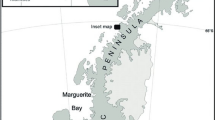Abstract
The dietary compositions and breadths of sequential 50 mm size classes of the six whiting species found in nearshore (<1.5 m), shallow inner-shelf (5 to 15 m) and/or deep inner-shelf (20 to 35 m) waters of the lower west coast of Australia were determined. Comparisons between the results of principal components analysis of head and mouth dimensions and the dietary compositions of Sillago bassensis, S. vittata, S. burrus, S. schomburgkii, S. robusta and Sillaginodespunctata suggests that any differences in the dietary composition of similar-sized representatives of different species, when they occur in the same habitat, are more likely to be due to differences in foraging behaviour than mouth morphology. Classification, ordination and Schoener's overlap indices showed that, in nearshore waters, the juveniles of Sillago bassensis, which colonise relatively exposed areas, have a different diet to those of the smallest representatives of the other whiting species that occupy more sheltered habitats. S. bassensis consumes mainly amphipods, whereas the smaller representatives of S. vittata, S. burrus, S. schomburgkii and Sillaginodes punctata ingest large volumes of copepods, which are typically abundant in protected nearshore waters. Although the mouth dimensions of S. punctata tend to be smaller than those of Sillago schomburgkii, the larger individuals of the former species ingest greater quantities of larger prey, such as crabs and carid shrimps. As S. bassensis, S. vittata and S. burrus increase in size and migrate out into shallow inner-shelf waters, the latter two species tend to concentrate more on benthic prey, while the former species ingests fauna that is more epibenthic. The largest S. bassensis subsequently migrate out into deep inner-shelf waters, where they co-occur with S. robusta, which is restricted to those waters. In these waters, S. bassensis feeds to a far greater extent on large benthic prey, whereas S. robusta consumes a greater quantity of small epibenthic crustaceans, differences that reflect the far larger lengths of the former species in that region. The above data emphasise that the distribution and ontogenetic movements of the six abundant species of whiting play a major role in facilitating a partitioning of food resources amongst these species found in coastal waters of the lower west coast of Australia.
Similar content being viewed by others
Author information
Authors and Affiliations
Additional information
Received: 7 October 1996 / Accepted: 31 January 1997
Rights and permissions
About this article
Cite this article
Hyndes, G., Platell, M. & Potter, I. Relationships between diet and body size, mouth morphology, habitat and movements of six sillaginid species in coastal waters: implications for resource partitioning. Marine Biology 128, 585–598 (1997). https://doi.org/10.1007/s002270050125
Issue Date:
DOI: https://doi.org/10.1007/s002270050125




